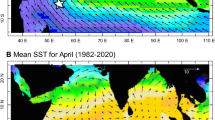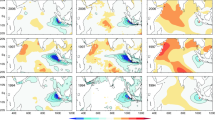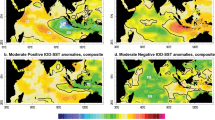Abstract
Sea-level reconstructions over the past two millennia provide a pre-industrial context to assess whether the magnitude and rate of modern sea-level change is unprecedented. Sea-level records from the Indian Ocean over the past 2,000 years are sparse, while records from the Atlantic and Pacific Oceans show variations less than 0.25 m and no significant negative excursions. Here, we present evidence of two low sea-level phases in the Maldives, Indian Ocean, based on fossil coral microatolls. Microatoll growth is constrained by low water levels and, consequently, they are robust recorders of past sea level. U–Th dating of the Maldivian corals identified lowstands at ad 234–605 and ad 1481–1807 when sea level fell to maximum depths of −0.88 m and −0.89 m respectively. These lowstands are synchronous with reductions in radiative forcing and sea surface temperature associated with the Late Antiquity Little Ice Age and the Little Ice Age. Our results provide high-fidelity observations of lower sea levels during these cool periods and show rates of change of up to 4.24 mm yr−1. Our data also confirm the acceleration of relative sea-level rise over the past two centuries and suggest that the current magnitude and rate of sea-level rise is not unprecedented.
This is a preview of subscription content, access via your institution
Access options
Access Nature and 54 other Nature Portfolio journals
Get Nature+, our best-value online-access subscription
$29.99 / 30 days
cancel any time
Subscribe to this journal
Receive 12 print issues and online access
$259.00 per year
only $21.58 per issue
Buy this article
- Purchase on Springer Link
- Instant access to full article PDF
Prices may be subject to local taxes which are calculated during checkout


Similar content being viewed by others
Data availability
The data supporting the findings of this study are available within the paper and its Supplementary Information files.
References
Kemp, A. C. et al. Climate related sea-level variations over the past two millennia. Proc. Natl Acad. Sci. USA 108, 11017–11022 (2011).
Church, J. et al. in Climate Change 2013: The Physical Science Basis (eds Stocker, T. F. et al.) 1137–1216 (IPCC, Cambridge Univ. Press, 2013).
Kopp, R. E. et al. Temperature-driven sea-level variability in the common era. Proc. Natl Acad. Sci. USA 113, 1434–1441 (2016).
Lambeck, K., Rouby, H., Purcell, A., Sun, Y. & Sambridge, M. Sea level and global ice volumes from the last glacial maximum to the holocene. Proc. Natl Acad. Sci. USA 111, 15296–15303 (2014).
Hallmann, N. et al. Ice volume and climate changes from a 6000 year sea-level record in French Polynesia. Nat. Commun. 9, 285 (2018).
Mann, M. E. et al. Global signatures and dynamical origins of the Little Ice Age and medieval climate anomaly. Science 326, 1256–1260 (2009).
Horton, B. P. et al. Mapping sea-level change in time, space, and probability. Annu. Rev. Environ. Resour. 43, 481–521 (2018).
Dutton, A., Webster, J. M., Zwartz, D., Lambeck, K. & Wohlfarth, B. Tropical tales of polar ice: evidence of last interglacial polar ice sheet retreat recorded by fossil reefs of the granitic Seychelles Islands. Quat. Sci. Rev. 107, 182–196 (2015).
Nicholls, R. J. et al. Sea-level scenarios for evaluating coastal impacts. Clim. Change 5, 129–150 (2014).
Schuerch, M. et al. Future response of global coastal wetlands to sea-level rise. Nature 561, 231–234 (2018).
Hinkel, J. et al. The ability of societies to adapt to twenty-first-century sea level rise. Nat. Clim. Change 8, 570–578 (2018).
Khan, N. S. et al. Holocene relative sea level changes from near-, intermediate-, and far-field locations. Curr. Clim. Change Rep. 1, 247–262 (2015).
Kemp, A. C. et al. Relative sea-level change in Newfoundland, Canada during the past ~3000 years. Quat. Sci. Rev. 201, 89–110 (2018).
Gerlach, M. J. et al. Reconstructing common era relative sea-level change on the Gulf Coast of Florida. Mar. Geol. 390, 254–269 (2017).
Woodroffe, C. D. Late quaternary sea-level highstands in the central and eastern Indian Ocean: a review. Glob. Planet Change 49, 121–138 (2005).
Woodroffe, C., McGregor, H. V., Lambeck, K., Smithers, S. G. & Fink, D. Mid-Pacific microatolls record sea-level stability over the past 5000 yr. Geology 40, 951–954 (2012).
Kench, P. S. et al. Holocene reef growth in the Maldives: evidence of a mid-holocene sea level highstand in the central Indian Ocean. Geology 37, 455–458 (2009).
Gischler, G., Hudson, J. H. & Pisera, A. Late quaternary reef growth and sea level in the Maldives (Indian Ocean). Mar. Geol. 250, 104–113 (2008).
Yokohama, Y. et al. Holocene Indian Ocean sea level, Antarctic melting history and past tsunami deposits inferred using sea level reconstructions from the Sri Lanka, southeastern Indian and Maldivian coasts. Quat. Sci. Rev. 206, 150–161 (2019).
Meltzner, A. J. & Woodroffe, C. D. in Handbook of Sea-Level Research (eds Shennan, I. et al.) 125–145 (Wiley, 2015).
Mann, M. E. et al. Proxy-based reconstructions of hemispheric and global surface temperature variations over the past two millennia. Proc. Natl Acad. Sci. USA 105, 13252–13257 (2008).
Oppo, D. W., Rosenthal, Y. & Linsley, B. K. 2,000-year-long temperature and hydrology reconstructions from the Indo-Pacific warm pool. Nature 460, 1113–1116 (2009).
Ljungqvist, F. C. A new reconstruction of temperature variability in the extra-tropical northern hemisphere during the last two millennia. Geogr. Ann. A 92, 339–351 (2010).
Sigl, M. et al. Timing and climate forcing of volcanic eruptions for the past 2,500 years. Nature 523, 543–549 (2015).
Büntgen, U. et al. Cooling and societal change during the Late Antique Little Ice Age from 536 to around 660 AD. Nat. Geosci. 9, 231–236 (2016).
Neukom, R. et al. Consistent multidecadal variability in global temperature reconstructions and simulations over the common era. Nat. Geosci. 12, 643–649 (2019).
Toohey, M. et al. Disproportionately strong climate forcing from extratropical explosive volcanic eruptions. Nat. Geosci. 12, 100–107 (2019).
Büntgen, U. et al. 2500 years of European climate variability and human susceptibility. Science 331, 578–582 (2011).
Miller, G. H. et al. Abrupt onset of the Little Ice Age triggered by volcanism and sustained by sea-ice/ocean feedbacks. Geophys. Res. Lett. 39, L02708 (2012).
Steinhilber, F., Beer, J. & Fröhlich, C. Total solar irradiance during the holocene. Geophys. Res. Lett. 36, L19704 (2009).
Gebble, G. & Huybers, P. The Little Ice Age and 20th century deep Pacific cooling. Science 363, 70–74 (2019).
Thompson, P. R. Forcing of recent decadal variability in the equatorial and northern Indian Ocean. J. Geophys. Res. Oceans 121, 6762–6778 (2016).
Widlansky, M. J., Timmermann, A. & Cai, W. Future extreme sea-level seesaws in the tropical Pacific. Sci. Adv. 1, 500560 (2015).
Peltier, W. R., Argus, D. F. & Drummond, R. Space geodesy constrains ice-age terminal deglaciation: the global ICE-6G_C (VM5a) model. J. Geophys. Res. Solid Earth 120, 450–487 (2015).
Roy, K. & Peltier, W. R. Space-geodetic and water level gauge constraints on continental uplift and tilting over North America: regional convergence of the ICE-6G_C (VM5a/VM6) models. Geophys. J. Int. 210, 1115–1142 (2017).
Linsley, B. K., Rosenthal, Y. & Oppo, D. W. Holocene evolution of the Indonesian throughflow and the Western Pacific warm pool. Nat. Geosci. 3, 578–583 (2010).
Gautier, E. et al. 2600-years of stratospheric volcanism through sulfate isotopes. Nat. Commun. 10, 466 (2019).
Edwards, R. L., Chen, J. H. & Wasserburg, G. J. 238U-234U-230Th-232Th systematics and the precise measurement of time over the past 500,000 years. Earth Planet Sci. Lett. 81, 175–192 (1987).
Shen, C. C. et al. High-precision and high-resolution carbonate 230Th dating by MC-ICP-MS with SEM protocols. Geochim. Cosmochim. Acta 99, 71–86 (2012).
Cheng, H. et al. Improvements in 230Th dating, 230Th and 234U half-life values, and U–Th isotopic measurements by multi-collector inductively coupled plasma mass spectrometry. Earth Planet. Sci. Lett. 371, 82–91 (2013).
Chiang, H. W., Lu, Y., Wang, X., Lin, K. & Liu, X. Optimizing MC-ICP-MS with SEM protocols for determination of U and Th isotope ratios and 230Th ages in carbonates. Quat. Geochronol. 50, 75–90 (2019).
Zhao, J. & Collins, L. in Encyclopedia of Modern Coral Reefs (ed. Hopley, D.) 1128–1132 (Springer, 2011).
Bessat, F. & Buigues, D. Two centuries of variation in coral growth in a massive porites colony from Moorea (French Polynesia): a response of ocean-atmosphere variability from south central Pacific. Palaeogeogr. Palaeoclimatol. Palaeoecol. 175, 381–392 (2001).
Morgan, K. M. & Kench, P. S. Skeletal extension and calcification of reef-building corals in the central Indian Ocean. Mar. Env. Res. 81, 71–82 (2012).
Acknowledgements
We thank LaMer Group and the Small Island Research Centre, Fares-Maathodaa, Huvadhoo atoll for logistical support, Government of the Maldives for research permission and A. Vila-Concejo, E. Beetham and T. Turner for field assistance. X.W. acknowledges funding support from the National Research Foundation of Singapore (grant nos. NRF2017NRF-NSFC001-047 and NRF-NRFF2011-08) and the Earth Observatory of Singapore.
Author information
Authors and Affiliations
Contributions
P.K. conceived the project. P.K., R.M., S.O., E.R. and K.M. undertook fieldwork. X.W. and L.K. performed U–Th dating. K.R. undertook GIA modelling of field location. P.K., R.M. and S.O. led manuscript development and interpretation. All authors contributed to manuscript revision.
Corresponding author
Ethics declarations
Competing interests
The authors declare no competing interests.
Additional information
Peer review information Primary Handling Editor: James Super.
Publisher’s note Springer Nature remains neutral with regard to jurisdictional claims in published maps and institutional affiliations.
Supplementary information
Supplementary Information
Supplementary Figs. 1–3, Field Setting and Tables 1–4.
Supplementary Dataset 1
230Th dates of microatoll samples from southern Maldives.
Rights and permissions
About this article
Cite this article
Kench, P.S., McLean, R.F., Owen, S.D. et al. Climate-forced sea-level lowstands in the Indian Ocean during the last two millennia. Nat. Geosci. 13, 61–64 (2020). https://doi.org/10.1038/s41561-019-0503-7
Received:
Accepted:
Published:
Issue Date:
DOI: https://doi.org/10.1038/s41561-019-0503-7
This article is cited by
-
Reef islands have continually adjusted to environmental change over the past two millennia
Nature Communications (2023)
-
Climate pacing of millennial sea-level change variability in the central and western Mediterranean
Nature Communications (2021)
-
Reply to: Climate did not drive Common Era Maldivian sea-level lowstands
Nature Geoscience (2021)
-
Climate did not drive Common Era Maldivian sea-level lowstands
Nature Geoscience (2021)



